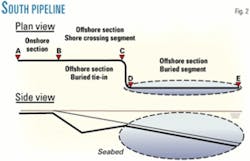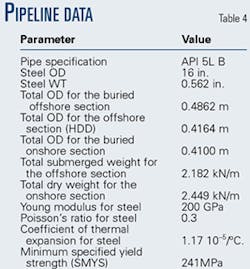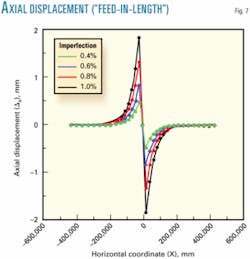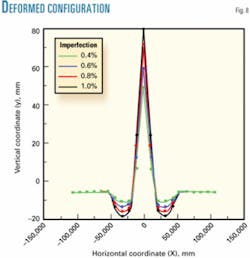Unique approach developed for installing heated export lines at Brazilian terminal
Expected operating conditions for two planned oil export pipelines at Petrobras' Capixaba North Terminal (TNC) prompted the company to modify conventional installation and burial procedures and provided it with the opportunity to study the behavior of buried heated pipelines.
The export pipelines of the Capixaba North Terminal offshore Brazil will be operating with a high potential for thermal stability because of the high temperatures needed to ensure adequate flow.
This article discusses the design and installation challenges that result from the narrow tolerance for error in installation and burial by a conventional lay barge.
Petrobras has taken advantage of the TNC project to investigate the behavior of buried heated pipelines. This work established a numeric tool that will serve as the basis for upheaval buckling analysis in new pipeline design.
A parametric study evaluated the influence of initial geometric imperfections (out of straightness, or nonlinearity, and measured in percent deviation from straight) generated from pipelay and burial on pipeline stability. The study yielded minimum buried depths for different predefined imperfections.
A few modifications were introduced to traditional installation procedures to ensure the pipeline's final position was in accordance with design requirements for such an imperfections. Testing these modifications proved them efficient to minimize such pipeline imperfections, but only the final as-laid configuration will show the real project results.
It is recommended, therefore, that further upheaval buckling analysis use the as-laid information when it is available after installation later this year. This will be the proper way to determine any remedial backfill required for pipeline vertical stability in buried offshore segments. An inertial navigation pig such as geopig can accurately measure the as-laid pipeline profile for such purpose.
TNC system
The TNC subsea system will consist of two pipelines connecting the onshore terminal to a subsea pipeline-end manifold (PLEM) and a monobuoy to export heavy oil. Two flexible hoses installed in a "Chinese lantern" configuration will connect the PLEM to the monobuoy, and then a floating hose will export the oil to the tanker. The subsea PLEM will have flow-control hydraulic valves operated from the onshore terminal by a subsea umbilical.
Two pipelines are necessary to allow a round trip intelligent pigging operation to comply with Brazilian laws and to remove heavy oil after each loading. The pipelines will be filled with light oil after the heavy oil has been removed. In both cases the valves positioned in the PLEM will be hydraulically operated from the terminal.
This article presents installation considerations based on limitations obtained from upheaval buckling analysis of the TCN export pipelines in the production field of Fazenda Alegre in Espírito Santo state.
Pipeline vertical instability was studied by referencing similar problems with a railroad track.1 2 Analytical and numerical modeling of upheaval buckling response in offshore pipelines has progressed rapidly over the last few years, from classical analyses3 4 to one covering initial imperfections5-8 to one additionally including large pipe displacement and associated cover non-linearity.9
A design method presented here is based on application of a computer program10 and on finite-element models developed to carry out analysis of pipeline upheaval buckling.11-13
The finite-element model employed for thermo-mechanical analysis considered the physical nonlinearity of the soil-heated pipe interaction and the pipeline physical and geometrical non-linearities. The pipeline's submerged weight, maximum operating differential pressure, and uniform temperature gradient in the pipeline wall were also considered.
A sensitivity study for different initial geometric imperfection height (δi) originated from laying operations and burial pipeline process aiming to verify the possibility of the global buckling (d), as illustrated in the Fig. 1, was carried out, and the pipeline structural integrity in the thermo-mechanical analysis was verified with API 1111.14
System configuration
Petrobras is planning to develop the Fazenda Alegre field, onshore in the Espírito Santo State. Its development strategy consists of an export terminal pumping hot oil to shuttle tankers via a marine monobuoy and two 16-in. symmetrical and identical export pipelines. In normal conditions, these pipelines (dubbed "north" and "south") would be operated simultaneously during offloading.
Layout of the pipelines, spools pieces, and tie-ins should allow passage of conventional and intelligent pigs. The monobuoy will be moored at 16-m waters and connected to a PLEM, which will receive and combine oil from both pipelines and redirect flow to the monobuoy through flexible hoses.
At the end of each operation, a flush of light oil will remove remaining heavy oil to ensure that pipeline cooling does not cause problems for subsequent offloading.
The tanker loading operation consists of the following steps:
- Pumping a foam pig into one pipeline in a round trip pig operation removes the light oil in the pipelines.
- The light oil returns to the terminal and the hydraulic valves on PLEM pump the heated heavy oil to tanker through both pipelines. Hydraulic valves on the PLEM again pump a foam pig with light oil through one pipeline and return the heavy oil to terminal.
The pipelines consist of offshore and onshore sections with an overall length of about 3,600 m. The offshore pipeline sections can be divided into two segments:
- The shore crossing segment, about 1,100 m and installed through horizontal directional drilling (HDD).
- The buried segment, about 2,140 m installed by S-lay barge followed by burial.
Buried subsea flanged spool pieces will tie-in both segments.
The offshore termination of the pipelines will be tied to the PLEM by a standard flanged spool piece, which will be left unburied on the seabed. The onshore sections, about 300 m, complete the pipelines from the shore crossing to the pig launchers at the terminal.
Fig. 2 illustrates the configuration for the south pipeline. Table 1 presents data for the system configuration, including data for the HDD and burial conditions.
Burial depths are measured from the lower soil level to the center of the buried pipe, and the angles are measured with respect to the horizontal and refer to Points B and C (Fig. 2). Vertical bends at Points B and C are the minimum values, which are five times the pipe OD. The offset between the shore crossing and the buried offshore segments is the minimum value established for tie-in design purpose, which includes the nominal offset reduced by installation tolerances.
Table 2 presents operational data. A clay-type soil (critical for the offshore sections) and a sand-type soil (applicable to the onshore section) were selected for thermal analysis. Table 3 presents the selected soil information for clay and sand. Table 4 presents material data for the steel pipe of the buried onshore and offshore segments.
Upheaval analysis
Finite-element modeling simulated the pipelines during operational situations. Thus the pipeline model is lowered on the seabed containing the initial geometric maximum allowable imperfection. The pressure and temperature are then imposed on the pipeline, with the temperature being gradually increased until the pipeline lifts off the imperfection and buckles upwardly.
The software ABAQUS V.6.3 was employed in the analysis where the pipeline is modeled with a fine uniform mesh of linear pipe elements.15 The model considers the pipeline ends clamped and nonmovable. An initial geometric imperfection is applied to allow a post-buckling load-displacement analysis. The pipeline-shape imperfection was defined with a polynomial equation as a profile.
The model is based on the von Mises yield criterion with isotropic strain hardening. The pipeline is made of an elastic-perfectly plastic metal, with Young's modulus 200 GPa, Poisson's coefficient 0.3, and minimum specified yield strength of 241 MPa. Residual stresses were not considered in the model.
ABAQUS provides a library of pipe-soil interaction elements to model the interaction between a buried pipeline and the surrounding soil. These elements have only displacement degrees of freedom at their nodes. One edge of the element shares nodes with the underlying pipe element.
The pipe-soil interaction behavior is elastic-perfectly plastic. The stiffnesses in the vertical, horizontal, and axial directions are usually different. It is further assumed that the pipeline is buried deeply so that the response is symmetrical about the origin.
Because the loading occurs in a plane (axial-vertical), the properties for the pipe-soil interaction behavior in the transverse horizontal direction are not important.
ABAQUS also provides analytical models that describe the pipe-soil interaction. They define the constant ultimate force that can be exerted on the pipeline. In other words, these models describe elastic-perfectly plastic behavior. ASCE Guidelines of the Seismic Design of Oil and Gas Pipeline Systems describes in detail the forms of these formulas that are suitable for use with sands and clays.16
The model developed in ABAQUS, considering all the loads and neglecting out-of-plan movements as a conservative assumption, was validated through a comparison of results generated in the analyses with the results obtained in the technical report by Intec Engineering using PCupbuck2 software.17
Parametric study
The upheaval buckling analysis considered an initial geometric imperfection, upon which the pipeline is laid. It has been shown that the most conservative deformed shape is the imperfection configuration of the fourth-order polynomial equation (see accompanying box), which basically considers the pipeline shape has continuously varying curvature.
A parametric study analyzed the results, presented here, for initial geometric imperfections of 0.4, 0.6, 0.8, and 1.0%. The temperature is evenly increased and the Von Mises stress is monitored for different buried depths with the objective of establishing the minimum allowable buried depth for each initial geometric imperfection.
Table 5 presents the buried depths and maximum vertical displacements at which the pipeline reaches 90% of SMYS14 for 70º C. gradient.
Before completing the analyses, it was necessary to calculate soil reactions for the different burial heights. The soil reactions were estimated based on the ASCE Guidelines of the Seismic Design of Oil and Gas Pipeline Systems.16 Fig. 3 shows the axial force-relative displacement relationship for clay.
The maximum load is reached at an ultimate relative displacement (Δa) and a conservative value of 10 mm (clay) for Δa is considered in the analysis. A linear elastic response is assumed for Δ, Δa.
The vertical behavior is described by different relationships for downward and upward motions. Downward motions yield positive displacements so that the positive forces are applied to the pipeline. Similarly, upward motions give rise to negative relative displacements and pipeline forces.
Fig. 4 shows the ultimate forces for downward and upward motions of the pipe in clay for different initial geometric imperfections and their respective burial depths.
Where the ultimate forces for downward and upward motions are respectively reached at a relative displacement of about Δvp=0.15D and Δvn=0.20H (if Δvn,0.20D, otherwise Δvn=0.20D) for clay.
Fig. 5 presents the graphic results of the parametric study generated by numerical model for upheaval buckling analysis, showing the Von Mises stress for initial geometric imperfections at which the pipeline reaches 217 MPa (90% of SMYS) for 70º C. temperature gradient.
Figs. 6 and 7, respectively, present results for maximum vertical displacement in the pipeline as a function of temperature and axial displacement in the pipeline as a function of the horizontal coordinate for the maximum temperature gradient (70º C.), which occurs at the middle and extremes, respectively, of the pipeline feed-in length, about 400 m.
Fig. 8 presents the deformed configurations for initial geometric imperfections at which the pipeline reaches 90% of SMYS for 70º C. temperature gradient. For larger initial geometric imperfections, analyses differ more significantly.
Installation
The subsea system will be installed in several phases.
- Installation Phase 1 deals with pipeline installation in the shore approach.
To cross the shore area, horizontal directional drilling was chosen to install the pipelines and hydraulic umbilical casing through which the umbilical will be pulled. The drilling equipment is to be positioned on the beach about 60 m from shoreline.
The pipelines and the casing section are to be constructed in an onshore yard and its length corresponds to about 1,100 m. Due to onshore space limitations, the pipelines and casing will be built in stalks of 550 m. The yard is to be prepared to receive, inspect, store the pipes, and construct the pipelines and casing stalks.
The pipes are to be cleaned, beveled, aligned, welded, and inspected and approved (nondestructively tested), and field-joint coated and inspected and approved.
After this phase, the stalks are flooded, gauged, and hydrostatically tested. Approved pipelines and casing sections are going to be prepared to be pulled offshore in a bundle (two 16-in. pipelines and one 12.75-in. casing).
To complete the total 1,100-m bundle, the first 550-m section will be pulled offshore and supported by a tow vessel, while the second section is welded near the beach area. After weld and anticorrosion coat approval the complete bundle is to be towed offshore to be positioned near the pre-drilled 46-in. hole.
Divers will then connect the bundle head to the drill pipe and swivel. Once connection is complete, pulling back operation starts by the drilling unit on the beach.
- Installation Phase 2 deals with pipelaying operations by S-lay and with PLEM installation.
This phase involves installing the two 16-in. pipelines by S-lay and tow method. To accomplish this task, the S-lay barge BGL-1, Petrobras property, is to be positioned near the deep end of the pipelines (16 m). On the other side (10 m depth), a support barge is to be positioned to receive the Petrobras pulling machine (CPM-600).
With the barge BGL-1 anchored, the pipelines will be constructed and towed to shallow water by the CPM-600 installed on the support barge positioned on the other pipeline end.
Such installation configuration is necessary to keep the pipeline prop as small as possible in accordance with the design considerations.
This configuration presents the following advantages when compared with normal S-laying: There are no moving anchors and thus no unexpected pipeline touchdown-point movement due to possible quick loss of barge position.
This configuration permits partial rectification of pipeline route by increasing tension during the towing operation. This operation is accomplished by keeping pipeline tension on BGL-1 and gradually increasing the force on CPM-600 installed on the other barge. To improve the rectification effect, the pipeline can be lightened by the use of buoys that are removed as soon as the pipeline installation is complete.
The need to control the pipeline imperfection during installationled to development of an LBL subsea monitoring system. It is based on two rows of transponders positioned on the seabed at both sides of the designed pipeline route. Once the transponders are calibrated, the pipeline is laid with one transponder positioned on the pipeline head and another portable transponder manipulated by a diver.
This system permits the on-line imperfection control and feeds the installation group with information to determine when it might be necessary to halt the laying operation and start the pipeline rectification operation.
This pipeline laying control system developed to verify the pipelines imperfections was tested in a gas pipeline laid by BGL-1 using the tow method. The values obtained during the survey corroborated the possibility of installing pipelines with this method considering the design imperfection requirements.
The PLEM is 6.8 m long, 5.325 m wide, and 2.48 m high; it weighs about 273.41 kN. This simple PLEM is supposed to be installed by a conventional support vessel with dynamic positioning and an A-frame astern. The installation tolerances for the PLEM are 1 m radius and the azimuth tolerance is ±5°.
- Installation Phase 3 consists of subsea and onshore tie-ins.
The onshore tie-in corresponds to the pipeline section between the terminal and beginning of directional drilling on the beach. There are two offshore tie-ins, one connecting the end of offshore directional drill to pipelines laid by BGL-1 and another tie-in connecting the pipelines to the PLEM.
The detail design of the onshore tie-in requires a horizontal curve of about 90° in the entrance of the directional drilling to minimize tensions and absorb pipeline expansion. Another loop is included near the entrance of the terminal to minimize expansion forces on pipelines ends where launching and receiving pigs are to be installed. The design depth of burial for the onshore pipeline section is 2.5 m.
- Installation Phase 4 consists of the hydrotest, the trenching operations, and the as-laid survey of the pipelines system.
Prior to trenching, pipelines will be tested to guarantee their integrity before the start of burying operations. All testing operations will be conducted onshore as both pipelines are designed to be interconnected by the PLEM.
The test consists of the pipeline flooding, gauging, testing, and geopig inspection whose function is to evaluate the pipeline coordinates and verify acceptable imperfection tolerance before trenching operation. Once hydrotest is completed and approved and the survey is completed, burying can start.
Pipeline burial will be by jetting machines. After burial, the geo-pig will be run again to confirm coordinates of the entire pipeline.
- Installation Phase 5 consists of monobuoy installation with its corresponding hoses. A support vessel is to install the anchors and chains and tighten the system before connecting them to the monobuoy. Once the monobuoy is in position, the Chinese lantern 16-in. hose configuration is to be installed. The last section of the 12-in. floating hoses is then connected to the monobuoy.
Acknowledgments
The authors thank Petrobras for sponsoring this work and giving permission to publish this article. The authors also acknowledge the support from the Federal University of Rio de Janeiro.
References
1. Martinet, A., "Flambement des Voies sans Joints sur Ballast et Rails de Grand Longueur" ("Buckling of Tracks without Joints on Ballast and Very Long Rails" in French), Revue Générale des Chemins de Fer, Vol. 55(2), 1936, pp. 212-30.
2. Kerr, A.D., "On the Stability of the Railroad Track in the Vertical Plane," Rail International, Vol. 5 (1974), pp. 132-42.
3. Hobbs, R.E., "In-service Buckling of Heated Pipelines," Journal of Transportation Engineering, Vol. 110 (1984), No. 2, pp. 175-1189.
4. Hobbs, R.E., and Liang, F., "Thermal Buckling of Pipelines Closed to Restraints," proceedings of the International Conference on Offshore Mechanics and Arctic Engineering, Vol. 5 (1989), pp. 121-27.
5. Taylor, N., and Gan, A.B., "Submarine Pipeline Buckling—Imperfection Studies," Thin Walled Structures, Vol. 4 (1986), pp. 295-323.
6. Ju, G.T., and Kyriakides, S., "Thermal Buckling of Offshore Pipelines," Journal of Offshore Mechanics and Arctic Engineering, Vol. 110 (1988), No. 4, pp. 355-64.
7. Pedersen, P.T., and Jensen, J.J., "Upheaval Creep of Buried Heated Pipelines with Initial Imperfection," Marine Structures, Vol. 1 (1988), pp. 11-22.
8. Pedersen, P.T., and Michelsen, J., "Large Deflection Upheaval Buckling of Marine Pipelines," proceedings of the International Conference on Behaviour of Offshore Structures, Vol. 3 (1988), Structures, pp. 965-80.
9. Croll, J.G.A., "A Simplified Model of Upheaval Thermal Buckling of Subsea Pipelines," Thin Walled Structures, Vol. 29 (1997), No. 1-4, pp. 59-78.
10. Palmer, A.C., Ellinas, C.P., Richards, D.M., and Guijt, J., "Design of Submarine Pipelines Against Upheaval Buckling," proceedings of the 1990 Offshore Technology Conference, No. OTC6335, pp. 551-59.
11. Klever, F.J., van Helvoirt, L.C., and Sluyterman, A.C., "A Dedicated Finite-Element Model for Analyzing Upheaval Buckling Response of Submarine Pipelines," proceedings of the 1990 Offshore Technology Conference, No. OTC6333, pp. 529-38.
12. Shaw, P.K., and Bomba, J.G., "Finite-Element Analysis of Pipeline Upheaval Buckling," proceedings of the International Conference on Offshore Mechanics and Arctic Engineering, Vol. 5 (1994), pp. 291-99.
13. Chiou, Y.J., and Chi, S.Y., "A Study on Buckling of Offshore Pipilines," Journal of Offshore Mechanics and Arctic Engineering, Vol. 118 (1996), pp. 62-70.
14. API RP 1111, Design, Construction, Operation and Maintenance of Offshore Hydrocarbon Pipelines (Limit State Design), Third Edition, 1999.
15. ABAQUS, Inc., "Abaqus Standard User's Manual," Version 6.3; 2002.
16. ASCE, "Guidelines of the Seismic Design of Oil and Gas Pipeline Systems," American Lifelines Alliance, 2001, Appendix B, pp. 68-76.
17. Bomfimsilva, C.T.P., "Thermal Analysis Report—Capixaba North Terminal," Technical Report—Intec do Brasil Ltda., 2003.
Based on a presentation to the 23rd International Conference on Offshore Mechanics and Arctic Engineering (ASME), June 20-25, 2004, Vancouver.
The authors
Rafael Familiar Solano is a pipeline engineer with Petrobras, working in the engineering department since July 2003. He is a mechanical engineer, having graduated from the Federal University of Rio de Janeiro in 1997 and holds a master of science in ocean engineering (2001) and is a DSc candidate in ocean engineering from the Federal University.
Fábio Braga de Azevedo is a pipeline engineer with Petrobras in the engineering department and is a mechanical engineer (1976) from the Federal University of Rio de Janeiro. He also holds a master of science in subsea engineering (1978) from Heriot-Watt University, UK.
Murilo Augusto Vaz is associate professor, Federal University of Rio de Janeiro, and a naval architecture and marine engineer (1985) from the Federal University. He holds a master of science in ocean engineering (1990) from the Federal University and a PhD from University College, London.
Carlos de Oliveira Cardoso is civil engineer with Petrobras, working at its research center since July 2003. He is civil engineer (1996) trained at the University of São Paulo State (USP) and holds master of science in civil engineering (1999) and DSc from the Federal University of Rio de Janeiro.


















